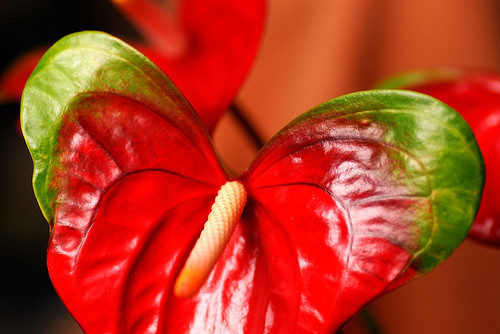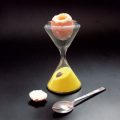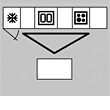 Anthurium flower homeland a - rainforest of the SouthAmerica. The genus Anthurium has about 600 species. In indoor culture, Scherzer's anthurium and Andre's anthurium are widespread as flowering plants, and crystal anthurium are common as decorative-leaved plants. Small nondescript flowers of anthurium, collected on the cob, are covered with a large leaf - a perianth, which is painted in various colors. Anthurium Andre has especially luxurious flowers - this species can reach a height of more than 1 meter. Cut flowers of certain varieties are very effective in bouquets. Dutch breeders offer such exotic varieties as Acropolis (yellow-orange cob, white blanket), Pistachio (pink-green cob, green blanket), Choco (green-white cob, chocolate colored blanket), and many others. in turn, as a species, it is distinguished by its small stature. It is mainly grown as a houseplant. Currently, three groups of hybrids have been bred: tall (up to 60 cm), medium-sized (30-45 cm) and miniature (5-10 cm).
Anthurium flower homeland a - rainforest of the SouthAmerica. The genus Anthurium has about 600 species. In indoor culture, Scherzer's anthurium and Andre's anthurium are widespread as flowering plants, and crystal anthurium are common as decorative-leaved plants. Small nondescript flowers of anthurium, collected on the cob, are covered with a large leaf - a perianth, which is painted in various colors. Anthurium Andre has especially luxurious flowers - this species can reach a height of more than 1 meter. Cut flowers of certain varieties are very effective in bouquets. Dutch breeders offer such exotic varieties as Acropolis (yellow-orange cob, white blanket), Pistachio (pink-green cob, green blanket), Choco (green-white cob, chocolate colored blanket), and many others. in turn, as a species, it is distinguished by its small stature. It is mainly grown as a houseplant. Currently, three groups of hybrids have been bred: tall (up to 60 cm), medium-sized (30-45 cm) and miniature (5-10 cm). Tall have a large numbersmall inflorescences with an oval-shaped veil are the varieties of Lady Jane, Renata. The middle-growth ones are with an inflorescence in the shape of a bent cob and a heart-shaped curtain bent down. Miniature varieties differ in very early flowering. All anthuriums, like tropical plants, are thermophilic and do not tolerate cold and drafts. They prefer a bright, but not sunny place and high humidity. In a dry place, these plants are sprayed. Anthurium leaves must be kept clean. Water the plants gradually, not allowing the soil to dry out. Once every two weeks, complex fertilizer is added to the irrigation water. In winter, anthuriums are fed more often - once a week. Poor drainage, too heavy soil and excessive watering can cause root rot. Young anthurium plants are transplanted annually in early spring. A thick layer of shards or expanded clay is placed on the bottom of the pot, the substrate is made of peaty fibrous earth and chopped moss, the pH value is necessarily weakly acidic, from 5 to 6. Anthurium has very brittle, fleshy roots, therefore, it is necessary to handle it with care when transplanting. It is very useful to pour a layer of fine expanded clay over the substrate.
Tall have a large numbersmall inflorescences with an oval-shaped veil are the varieties of Lady Jane, Renata. The middle-growth ones are with an inflorescence in the shape of a bent cob and a heart-shaped curtain bent down. Miniature varieties differ in very early flowering. All anthuriums, like tropical plants, are thermophilic and do not tolerate cold and drafts. They prefer a bright, but not sunny place and high humidity. In a dry place, these plants are sprayed. Anthurium leaves must be kept clean. Water the plants gradually, not allowing the soil to dry out. Once every two weeks, complex fertilizer is added to the irrigation water. In winter, anthuriums are fed more often - once a week. Poor drainage, too heavy soil and excessive watering can cause root rot. Young anthurium plants are transplanted annually in early spring. A thick layer of shards or expanded clay is placed on the bottom of the pot, the substrate is made of peaty fibrous earth and chopped moss, the pH value is necessarily weakly acidic, from 5 to 6. Anthurium has very brittle, fleshy roots, therefore, it is necessary to handle it with care when transplanting. It is very useful to pour a layer of fine expanded clay over the substrate.

Making Money with Desserts: Success Stories
Yevhen Polishchuk (Fedutinov) instagram: @ evgeniyafedutinovavk.com / janeshomebaking– It all started with baking for relatives and friends. Gradually, she began uploading photos of her baking to Instagram, and orders began to come in. I made my first cake to order on October 13, 2014, and a little earlier I started making macarons and cupcakes. We can say that the business "found me myself", I am very [...]

Soups are cold recipes with photos
Cold cucumber soup with yogurt and lemonSorbet from La Taverna restaurant chef Alexander Zhurkina Photo: Getty Images Ingredients: Yoghurt without additives - 125 gCucumber - 150 gSorbet lemon / lime - 50 gCool shrimp - 24 gFresh ginger - 1 gLime lime - 5 gFresh orange juice - 5 gPetroshka - 1 g pink - 1 gCress salad - […]

barbeque kebab
Pork tenderloin glaze Photos: Dmitry Bayrak / dbstudio Cooking time: 20 minutes + time for pickling. Calorie content: 454 kcal per 1 serving. For 4 servings: 4 pork tenderloin (about 300 g each), 1 onion, 2 cloves of garlic, 1 tsp. lemon peel, 1 tsp. lemon juice, a pinch of ground cumin, coriander and turmeric, 1 tbsp. l vegetable [...]

Pierre Duacan: dietary recipes: Ducane diet
Beetroot Photo: Season'S, Luxury Hotels Representation You will need: · Boiled beets - 60 g · Fresh cucumbers - 20 g · Red radish - 20 g · Green onions - 10 g · Egg - 1 pcs · Mineral drinking water - 200 g · Salt - 1 g Ready: · Boil egg and beetroot. · Grind cucumbers, radishes and a part of beets. Putting everything [...]





